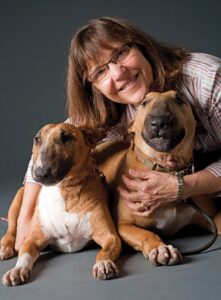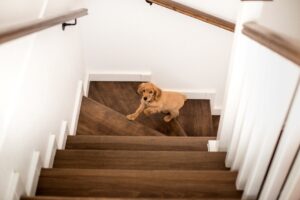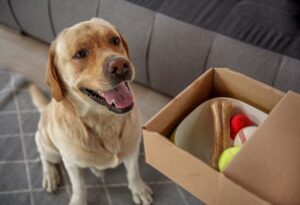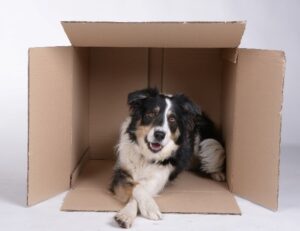-
Adopt
-
Veterinary Care
Services
Client Information
- What to Expect – Angell Boston
- Client Rights and Responsibilities
- Payments / Financial Assistance
- Pharmacy
- Client Policies
- Our Doctors
- Grief Support / Counseling
- Directions and Parking
- Helpful “How-to” Pet Care
Online Payments
Referrals
- Referral Forms/Contact
- Direct Connect
- Referring Veterinarian Portal
- Clinical Articles
- Partners in Care Newsletter
CE, Internships & Alumni Info
CE Seminar Schedule
Emergency: Boston
Emergency: Waltham
Poison Control Hotline
-
Programs & Resources
- Careers
-
Donate Now
 By Terri Bright, Ph. D., BCBA-D, CAAB, Director of Behavior Services
By Terri Bright, Ph. D., BCBA-D, CAAB, Director of Behavior Services
angell.org/behavior
617-522-5055 x 5297
Whether physically or intellectually stimulating, exercise is important for your dog. Most dogs will benefit from 30-45 minutes of large-muscle exercise every day, and the same is true of mental exercise, as well. Contrary to popular belief, exercise is not a cure for behavior, per se; if one uses the helpful metaphor of a two-year-old child for a dog, and imagines an over-tired two-year-old human, it is clear that the right amount and type of exercise is important. An old or infirm dog may best benefit from simple walking around a bit without stairs and searching for a piece of kibble every night, while a young sporting- or hunting-breed dog may need to run up and down the hallway 25 times and search for his whole meal. These exercises are meant to combine fun and training whenever it is either too hot or cold to work outside, or when someone simply does not have the time on any given day. For any of these exercises, do them with your dog’s meal and/or with high-value treats such as string cheese or small pieces of meat. If the dog is not interested, the food reward is not motivating; up the reward. Some dogs may prefer to work for a toy, instead.
For all of these, having fun and bonding with the dog should be the goal. Do not scold or correct your dog, but make it easy for them to earn the reward. Keep sessions short and involve the whole family, and do these in any order, when it is convenient for you:
 Stair recall: Find a set of stairs. Stand at the top with your dog. Show them a treat, and throw the treat to the bottom of the stairs for your dog to chase and get. After they eat it, call them to you. If you do not have stairs, use a long hallway or any room where you have the longest space for the dog to run. Toss the treat to the end of the hall/room; call the dog to you; when they get to you, praise and throw another treat. If they do not have much of a recall, start halfway up the stairs or down the hall and work your way toward longer distances.
Stair recall: Find a set of stairs. Stand at the top with your dog. Show them a treat, and throw the treat to the bottom of the stairs for your dog to chase and get. After they eat it, call them to you. If you do not have stairs, use a long hallway or any room where you have the longest space for the dog to run. Toss the treat to the end of the hall/room; call the dog to you; when they get to you, praise and throw another treat. If they do not have much of a recall, start halfway up the stairs or down the hall and work your way toward longer distances.- Variation on #1 Have your dog sit/stay at one end of the stairs or hall. You walk to the other, or to the distance you predict they will tolerate and stay. Call them to you. Praise as they come towards you, and bring them right in front of you into a sit position using a treat as a lure. They should be close enough so you can touch their head, and should be centered directly in front of you. Give them the treat. Then, lure them to your left side and have them sit/stay; walk away again. Repeat.
- The floating dinner bowl: Holding your dog’s bowl of food, ask them to sit. Slowly begin to lower the bowl. If they get up, raise the bowl up and remind them to sit. Do this until they hold their sit until the bowl is on the floor and you release by saying, “Okay!” (Note, the first few times you do this, expect it to take a while; be patient!)
 Sniffer dog game: With the dog at your side in a sit/stay, put a treat on the floor about 6 feet in front of them (if they haven’t mastered a sit/stay, have someone hold them). Release them, saying “Find it!” Put the next treat farther away. Then put two treats farther away. Gradually make the game harder, by putting treats under something or around a corner. Then put some food in a box, and let the dog sniff out which box has food in it. Gradually add more boxes, and place them at different heights; you can even use objects such as old handbags and briefcases or other containers to hold food for him to find. This is also a fun game to play with your dog’s favorite toy.
Sniffer dog game: With the dog at your side in a sit/stay, put a treat on the floor about 6 feet in front of them (if they haven’t mastered a sit/stay, have someone hold them). Release them, saying “Find it!” Put the next treat farther away. Then put two treats farther away. Gradually make the game harder, by putting treats under something or around a corner. Then put some food in a box, and let the dog sniff out which box has food in it. Gradually add more boxes, and place them at different heights; you can even use objects such as old handbags and briefcases or other containers to hold food for him to find. This is also a fun game to play with your dog’s favorite toy.- Snuffle mat: A “snuffle” mat is another way to deliver food for your dog to find with their nose. It looks like a shag rug square, and is available in pet stores and on the Internet. You stuff pieces of kibble into the mat for your dog to sniff out and eat.
- Pupcake: Another good way to entertain your dog with food is to make a “pupcake:” Take a metal cake pan and put an inch or two of water in it. Add a tablespoon of meat broth and a handful of kibble/treats. Top with grated cheese, then freeze. The more water you add, the longer it will take your dog to get through this fun frozen meal.
 101 Things to Do with a Box: Get a clicker and some treats and a cardboard box. Set the box down and click/treat your dog for interacting with it in any way − nose-touches, foot-bumps, foot in, 2 feet in, etc. In this way, gradually “shape” what your dog does with the box. Easy = nose-bumps. Hard= feet in the box. Hardest: back feet in the box!
101 Things to Do with a Box: Get a clicker and some treats and a cardboard box. Set the box down and click/treat your dog for interacting with it in any way − nose-touches, foot-bumps, foot in, 2 feet in, etc. In this way, gradually “shape” what your dog does with the box. Easy = nose-bumps. Hard= feet in the box. Hardest: back feet in the box!- Agility: Balance a stick across two cans and click/treat or praise/treat your dog for jumping over it. Cut the bottom from a new 55-gallon trash can and you have a tunnel (and if you have a smaller dog, you can use a cat tunnel or child’s toy tunnel). You can include furniture or dog beds in your “course.” Start the course with your dog in a sit/stay. Lead out past the jump. Call your dog to you over the jump and send them through the tunnel, then to a down/stay on the dog bed for 5 seconds. Make up your own course and obstacles throughout the house.
- Hide and seek: Have one person hold the dog by the collar. Have someone else go and hide somewhere in the house; make sure the dog does not see where they go, but keep it easy at first. Release the dog’s collar and say “Find!” When the dog does find the person, praise the dog and give it a treat.
- Stuff in a pail: Keep a lot of inexpensive toys and balls on hand, but save them for a rainy day. Then, dump all of them into a pail or big basket; then, put this fun-filled basket on the floor. We don’t care if they rip up the toys, as long as they don’t ingest parts or squeakers! When your dog has emptied the basket once, put everything back into it that wasn’t wrecked. A reduced version of this is to put the dog’s favorite toy into a paper bag or a box and close it up; let the dog tear it up to get the toy. (Again, if they will swallow the whole bag or box, this is not the game for them.) For dogs that ingest paper or cardboard, put a few treats in the spaces of a muffin tin, then put a tennis ball into each space. Show your dog there are treats there at first, then let them sniff them out.